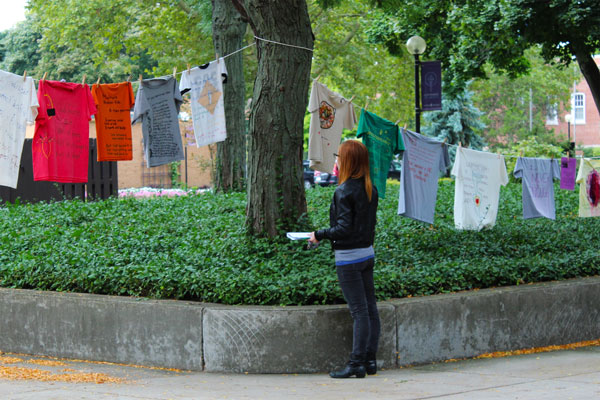“Hear my prayer, O Lord. Let my cry for help come to you.”
“I am tired of being afraid.”“We will not be silent.”
“Where was god that night?”
“She no longer hangs her head in silence – her chin is up. She no longer hides her missing teeth – her beautiful smile shines. Her confidence will rise.”
“I am stronger than vengeance. I am stronger than hatred. I am not allowing what you did to define who I am. I am strong enough to forgive you.”
These are the stories of our mothers, our sisters, our friends, our peers, our women, our non-binary people, our community.
These are the stories written on shirts hanging in Schrock Plaza this week as a part of Sexual Violence Awareness Week, hosted by the Goshen Student Women’s Association.
The Clothesline Project was started in 1990 in a small town in Massachusetts as part of an annual Take Back the Night March and Rally. The idea was born out of wanting to reimagine the clothesline from being ‘women’s work’ to a place of shared stories and experiences that empower women and non-binary people. Since then, this concept has spread to many towns and campuses searching to tell the stories of sexual violence and to affirm the survivors in each community.
The concept of the clothesline is simple: “to let each woman tell her story in her own unique way, using words and/or artwork to decorate her shirt,” as outlined on the Clothesline Project’s website. The action of hanging the clothes serves as both an educational tool for those who come to view the Clothesline and a healing tool those who tell their stories.
The survivors, friends and family can literally turn their backs on some of that pain of their experience and walk away from the physical clothesline, and the tangible, public stories can allow those who are still suffering in silence to know that they are not alone.
“The Clothesline and Red Dress Projects are powerful because they are a completely visual response to sexual violence,” said Claire Frederick, a senior and leader of GSWA. “Not only can survivors and victims share their stories as they choose, but everyone has a chance to learn about the realities of the writers and reflect on the stories they read. These projects are eye-opening for some and healing for others, the effect they have is dependent on the individual experiencing the project.”
The original project gave the colors of the shirts a specific meaning, but GC’s project did not follow those. According to the Clothesline Project’s website, white represents women who have died because of violence; yellow or beige represents battered or assaulted women; red, pink, and orange are for survivors of rape and sexual assault; blue and green t-shirts represent survivors of incest and sexual abuse; purple or lavender represents women who were attacked because of their sexual orientation; black is for women attacked for political reasons.
Along with these meanings, Goshen’s clothesline has another new addition this year. GSWA started the Red Dress Project to do in tandem with the Clothesline Project.
“This project is ‘an aesthetic response to the more than 1000 missing and murdered Aboriginal Women in Canada,’” said Frederick. “This week as you walk through Schrock Plaza, notice the red dress hanging from the clothesline, which represents our support for these women and their families.”
The Clothesline Project has spread as a grassroots effort to 500 national and international projects with an estimated 50,000 to 60,000 shirts. These projects have happened in 41 states and 5 countries with the hope of continued expansion.
“I hope these projects are a catalyst for those who are able to take action,” Frederick said. “After learning about stories from your own community, I hope you feel responsibility to attend PIN Trainings, wear purple and teal [on Thursday Sept. 29] and walk with survivors during Take Back the Night.:
The Clothesline Project hopes to honor survivors and victims of sexual violence through awareness and sharing.
“It is the very process of designing a shirt,” their website states, “that gives each woman a new voice with which to expose an often horrific and unspeakable experience that has dramatically altered the course of her life. Participating in this project provides a powerful step towards helping a survivor break through the shroud of silence that has surrounded her experience.”



